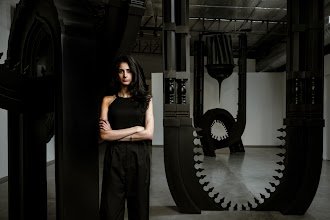
Artist Ayesha Singh And The Many Voices Of Historical Buildings
NEW DELHI, (IANS) – The inner silence of buildings is translated into a script of the physical. Whispers continue to resound. In the endless corridors of meanings, sub-texts and contemporary relevance, artist Ayesha Singh creates tangible thoughts celebrating/celebrating multiple possibilities with reality at its most profound.
In her dialogues with the past and present, many things are left unsaid only to be felt. She says in these times of continuous ideological shifts, the significance of monuments and memories has become more prominent in her readings and conversations.
This Delhi-born artist, who completed her MFA in Sculpture at the School of the Art Institute of Chicago and BFA from the Slade School of Fine Art in London, works with drawings, performance, installation, sculpture, and video to question the assumed permanence of buildings and the histories omitted during construction and restoration. Her work involves subversive actions that highlight existing socio-political hierarchies and the assertion of established systems of power in architecture.
Her works stress the fact that the ancient continues to breathe, consistently shaping our present, specifically ‘Frayed Continuum’ which is a machine that dips nine 50-90-year-old wooden architectural fragments into cement, speaking to continuous alteration and the assertion of the past beneath the facade of new construction.
“‘Monumental Turns’ also delves into the opposite simultaneously, drawing references to ways in which our past is altered by present value systems and the dominating ideologies. The works here point to so many of the complexities we encounter in cities, including shifting power dynamics, the desire for belonging, imagined futures, and erasures,” she adds.
Talking about Delhi, a vast city, that she says is spread in a way that one cannot fully know each crevice of it, Singh asserts that she does have a strong sense of belonging to many spaces there, albeit transient.
“My research often takes me to areas I may not have encountered before or rediscover a familiar space through changed perspectives such as revisiting the Qutub Complex for ‘Skewed Histories’.”
Singh, who reveals the politics and power in a building’s layers, believes scale, material and form affect how we maneuver through and around architecture. From spaces of worship to governance, the way we behave and the subconscious relations we develop with a building are initially, and intentionally, dictated via design.
“While architecture is often perceived as passive, it plays a far more active role in our everyday experience of a city. My work often looks at those personal experiences of larger decision-making that surpass individual agency, and the connotative functioning of their construction. To further that, towards questioning accepted histories, collective fact-making, and their proven malleability through architecture,” she says.
And it is the construction and ornamentation of a building that fascinates her. She often finds herself looking at the material used, especially when facades that look like brick are made with polyurethane foam and windowsills that look like wood are plastic panels.
“The creation of facade, ideals, and aspirations speak through material and form, I often find myself delving into those details,” says the artist.
Remembering her encounter with British art aesthetics during her BFA, Singh recounts that when she was learning about art history in the global west, including Bourriaud’s ideas about relational aesthetics, she sought out reading groups on post-colonial theory, and worked with an artist-book publisher and a gallery from South Asia, outside of the university curriculum.
“The ideas in each experience later evolved to alter the figurative paintings I was making in high school, to walk-around installations made with found objects, including carpets and cable trays, to foam, photographs, and drawings during my BFA.”
A co-founder of Art Chain, an active marketplace for artists, showcasing their work under the hashtag #ArtChainIndia started during the pandemic, the artist stresses that in the post-pandemic world, the range of resources accessible to all has been broadened, encompassing knowledge-sharing on art law and intellectual property in India.
“There have been mentorship, workshops, and session opportunities for ACI artists and the wider public. We look forward to unveiling new developments and exciting updates for our audiences soon.”
On her next project, she smiles, “It is an adventure I would be happy to announce once I reach there!”




